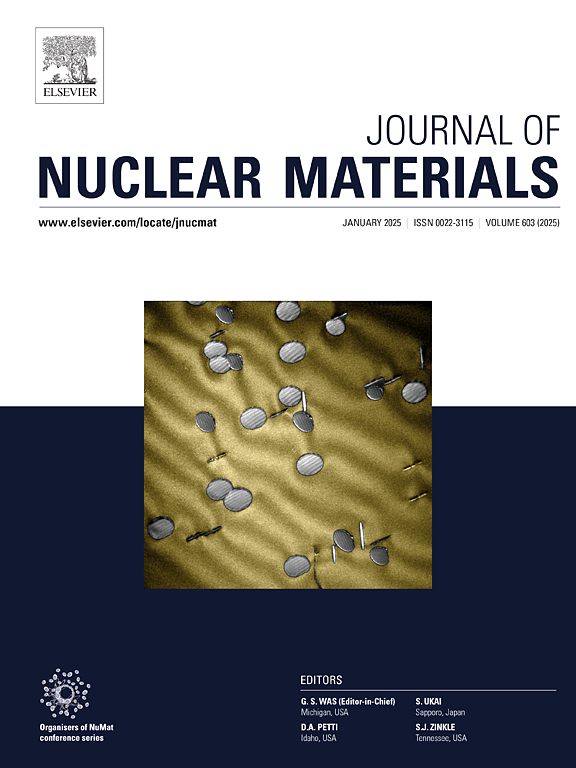高辐照沸水堆燃料棒燃料包壳界面三维显微x射线荧光和衍射分析
IF 2.8
2区 工程技术
Q3 MATERIALS SCIENCE, MULTIDISCIPLINARY
引用次数: 0
摘要
在轻水反应堆的核燃料辐照过程中,由于反应堆堆芯的高温高压,燃料包层会爬到氧化铀燃料球团上。随着燃耗的增加,铀裂变导致氧气过剩,在包层的内表面形成氧化层,导致燃料包层粘合。这个结合了裂变产物的键合层对颗粒包层的机械相互作用很重要。本文对瑞士沸水堆(61 GWd/tU)辐照高燃耗乏燃料的燃料包壳界面(FCI)区域进行了研究。在层析模式下,利用微束x射线荧光(µXRF)和x射线衍射(µXRD)实验进行了微观结构表征。所有测量都是在Paul Scherrer研究所的瑞士光源同步加速器的microXAS光束线上进行的。使用聚焦离子束(FIB)技术制备了FCI感兴趣区域尺寸约为34 μ m x 34 μ m x 18 μ m的微米级小样品,然后进行分析。利用高空间分辨率获得的µXRF图,将化学成分与XRD鉴定的晶相联系起来。结果表明,尽管在低沸水堆的温度和压力条件下,四角形氧化锆是燃料和包层之间键合层的主要相,但它是一种亚稳态相。晶格参数在氧化锆层中演化,在Zr/ZrO2界面处参数较小,在ZrO2/UO2界面处参数较大。这可能表明应力和/或裂变产物使相稳定。XRD分析可以评估所识别相的晶格参数,其中包层附近的UO2为5.474 Å。此外,XRF分析显示氧化锆层内存在Kr气泡。本文章由计算机程序翻译,如有差异,请以英文原文为准。
3D microscopic X-ray fluorescence and diffraction analysis of a fuel-cladding interface of a highly irradiated boiling water reactor fuel rod
During irradiation of nuclear fuel in light water reactors (LWRs), the fuel cladding creeps onto the uranium oxide fuel pellets due to the high temperature and pressure in the reactor core. With increasing burnup, the uranium fission leads to a surplus of oxygen that creates an oxide layer at the inner surface of the cladding which causes a fuel-cladding bonding. This bonding layer, that incorporates fission products, can be important for the pellet-cladding mechanical interaction. The present study focuses on the fuel-cladding interface (FCI) region of a high burnup spent fuel irradiated in a Swiss Boiling Water Reactor (61 GWd/tU). A microstructural characterization was carried out using a combined microbeam X-ray fluorescence (µXRF) and X-ray diffraction (µXRD) experiment in tomographic mode. All the measurements were carried out at the microXAS beamline of the Swiss Light Source synchrotron, at the Paul Scherrer Institute, PSI. A small micrometer-scale sample of a size of approximately 34 µm x 34 µm x 18 µm of the region of interest at the FCI was prepared using the focused ion beam (FIB) technique and then analyzed. The µXRF maps, obtained with high spatial resolution, were used to correlate the chemical composition with the crystalline phases identified using XRD. The results show that tetragonal zirconia is the main phase present in the bond layer between fuel and cladding, although it is a metastable form under the temperature and pressure conditions of a LWR. Lattice parameters evolve through the zirconia layer, with smaller parameters at the Zr/ZrO2 interface and larger ones at the ZrO2/UO2 interface. This may indicate phase stabilization by stresses and/or fission products. XRD analysis allowed evaluating the lattice parameters of the identified phases, among others for UO2 near the cladding, which was 5.474 Å. In addition, XRF analyses revealed the presence of Kr bubbles within the zirconia layer.
求助全文
通过发布文献求助,成功后即可免费获取论文全文。
去求助
来源期刊

Journal of Nuclear Materials
工程技术-材料科学:综合
CiteScore
5.70
自引率
25.80%
发文量
601
审稿时长
63 days
期刊介绍:
The Journal of Nuclear Materials publishes high quality papers in materials research for nuclear applications, primarily fission reactors, fusion reactors, and similar environments including radiation areas of charged particle accelerators. Both original research and critical review papers covering experimental, theoretical, and computational aspects of either fundamental or applied nature are welcome.
The breadth of the field is such that a wide range of processes and properties in the field of materials science and engineering is of interest to the readership, spanning atom-scale processes, microstructures, thermodynamics, mechanical properties, physical properties, and corrosion, for example.
Topics covered by JNM
Fission reactor materials, including fuels, cladding, core structures, pressure vessels, coolant interactions with materials, moderator and control components, fission product behavior.
Materials aspects of the entire fuel cycle.
Materials aspects of the actinides and their compounds.
Performance of nuclear waste materials; materials aspects of the immobilization of wastes.
Fusion reactor materials, including first walls, blankets, insulators and magnets.
Neutron and charged particle radiation effects in materials, including defects, transmutations, microstructures, phase changes and macroscopic properties.
Interaction of plasmas, ion beams, electron beams and electromagnetic radiation with materials relevant to nuclear systems.
 求助内容:
求助内容: 应助结果提醒方式:
应助结果提醒方式:


